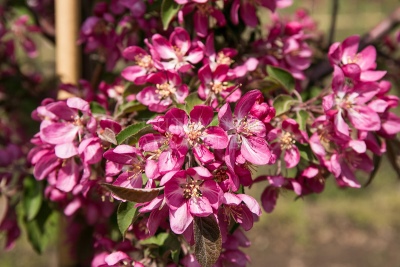
- Taste: tart
- Fruit size: small
- Ripening terms: autumn
- Removable maturity: beginning of September
- Appointment: fresh, making stewed fruit, making jam
- Name synonyms: Makowiecki, purple Makowiecki, Makowiecki, Makowiecki, Makowieckiana
- Self-fertility: self-pollinated
- Early maturity: early
- Decorative: Yes
- Height: 5-6 m
The Makovetsky apple tree is a fast-growing ornamental variety belonging to the Nedzvetsky purple apple tree group. The Makovetsky apple tree borrowed from its relative good winter hardiness and lush, bright flowering.
Description of the variety
The variety is characterized by the following external features:
vigorous bush, 5-6 m high;
the crown is dense, spreading, but with age it becomes drooping;
the leaves are whole, turn red at the blooming stage, turn green in the summer, acquire a yellowish-brown tint in the fall;
shoots are widely spread, up to 5 m long;
flowers are dark pink, large, grow one at a time, up to 5 cm in diameter.
Features, pros and cons
It is a self-pollinated variety, the tree itself is capable of acting as an effective pollinator. And also the pluses include the amazing appearance of the tree, the plant can become the main decoration of the site. Among the minuses, the tart taste of apples can be noted, but the culture was originally created not for harvesting, but as an ornamental plant.
Ripening and fruiting
This is a variety with an autumn ripening period, removable maturity occurs at the beginning of September.
Yield
The productivity of an apple tree is difficult to calculate, since it is grown mainly for beauty. But if you study the reviews of gardeners, then we can conclude that, on average, 25-50 kg of fruit can be removed from one tree. This amount may change every year depending on the weather.
Fruits and their taste
Despite the tart taste of apples and their small size (only 45-50 g), they are quite suitable for fresh consumption, for making compote or jam. Moreover, some gourmets, on the contrary, appreciate just such a sour taste. The apples themselves are oval or spherical and purple-red in color.

Growing features
To ensure comfortable conditions for growing a tree, you should take responsibility for planting it. Take advantage of several expert recommendations.
Choose a sunny, wind-protected place for planting where water does not accumulate. If the area is somewhat shaded, then the plant will lose the brightness of flowers and foliage.
The optimal type of soil is moist and fertile soil, loam with a slightly acidic reaction.
The groundwater flow should not be closer than 2 m to the surface.
Planting can be done in early spring or autumn, about a month before the first frost.
When planting, it is important not to deepen the root collar, it should be 5-6 cm above ground level.
After planting, water the seedling with 2-3 buckets of water.
When planting in groups, keep a distance of 5 m between seedlings.
Consider a number of factors when caring for young shrubs.
Young specimens require 2-3 waterings per month.At the stage of ripening, irrigation must be stopped so that the fruits do not crack.
The presented variety responds well to mulching. Mulch can be, for example, pine bark, sawdust, nut shells.
Pay special attention to sanitary pruning, during which you need to carefully eliminate old and damaged branches, as well as shoots growing towards the trunk.
Formative pruning consists in harvesting a third of the height in the first year of life and the formation of 2-4 skeletal branches. It is important to place them at a great distance from each other at different heights. Further, the form can be arbitrary.



Top dressing
Frequent feeding of Makovetsky's apple tree is not needed. For example, in the early years, the tree may not be fertilized at all. Further, top dressing is applied in the spring; urea can be used as additional food. This remedy will be especially relevant if the shrub has a growth retardation, passive flowering, yellowing leaves. During the rainy season, the crop is not sprayed.

Frost resistance
The presented variety has a high level of frost resistance. In the southern regions, insulation for the winter is not required. When grown in the northern regions, the trunks can be wrapped in burlap for the winter, the roots can be covered with straw, spruce branches, and foam. In early spring, the protective shelter must be removed before sap flow begins.

Diseases and pests
The plant has good resistance to diseases and pests, but sometimes it can be affected by scab, powdery mildew and other ailments. If the fruits will not be eaten, then the tree can be treated with chemicals. Means "Skor", "Topaz", copper sulfate help well against the fungus. To protect against ticks and leaf-eating insects, systemic insecticides are suitable.

The apple tree is a popular fruit crop among gardeners. It can be found in many summer cottages. But at the same time, such trees are often affected by various diseases.It is very important to recognize the disease in time and carry out the necessary procedures for a speedy recovery. Otherwise, the fruits will be spoiled, and the tree itself may die altogether.












































































